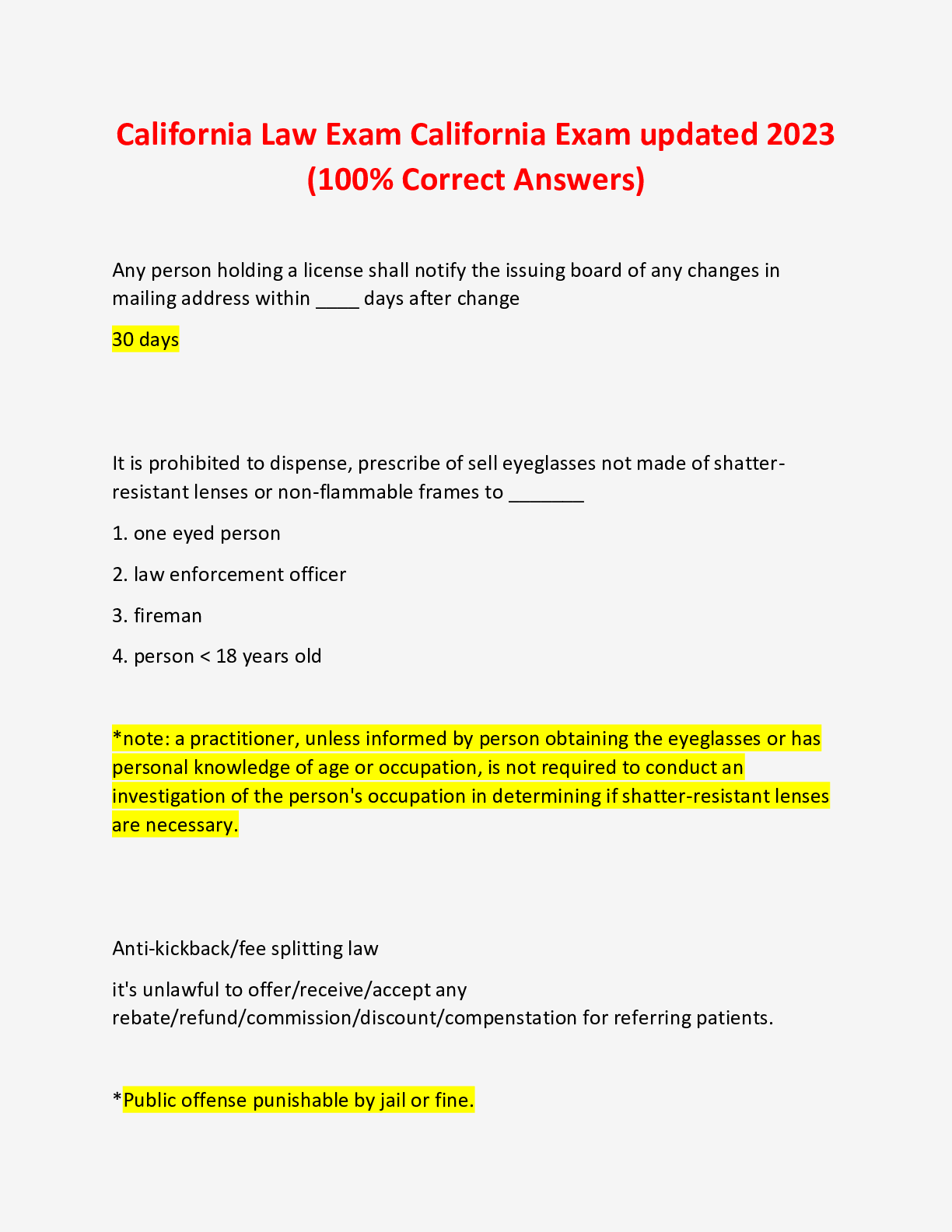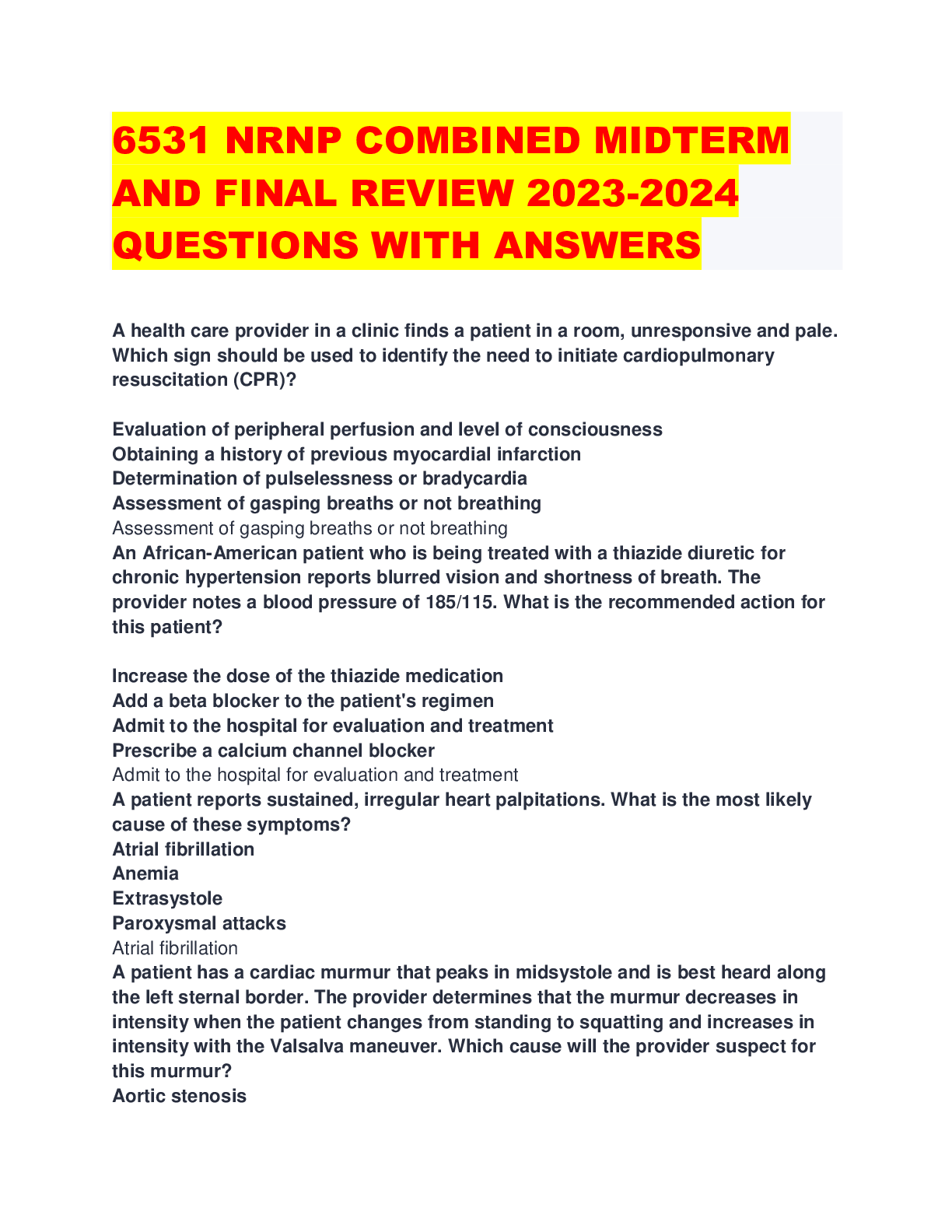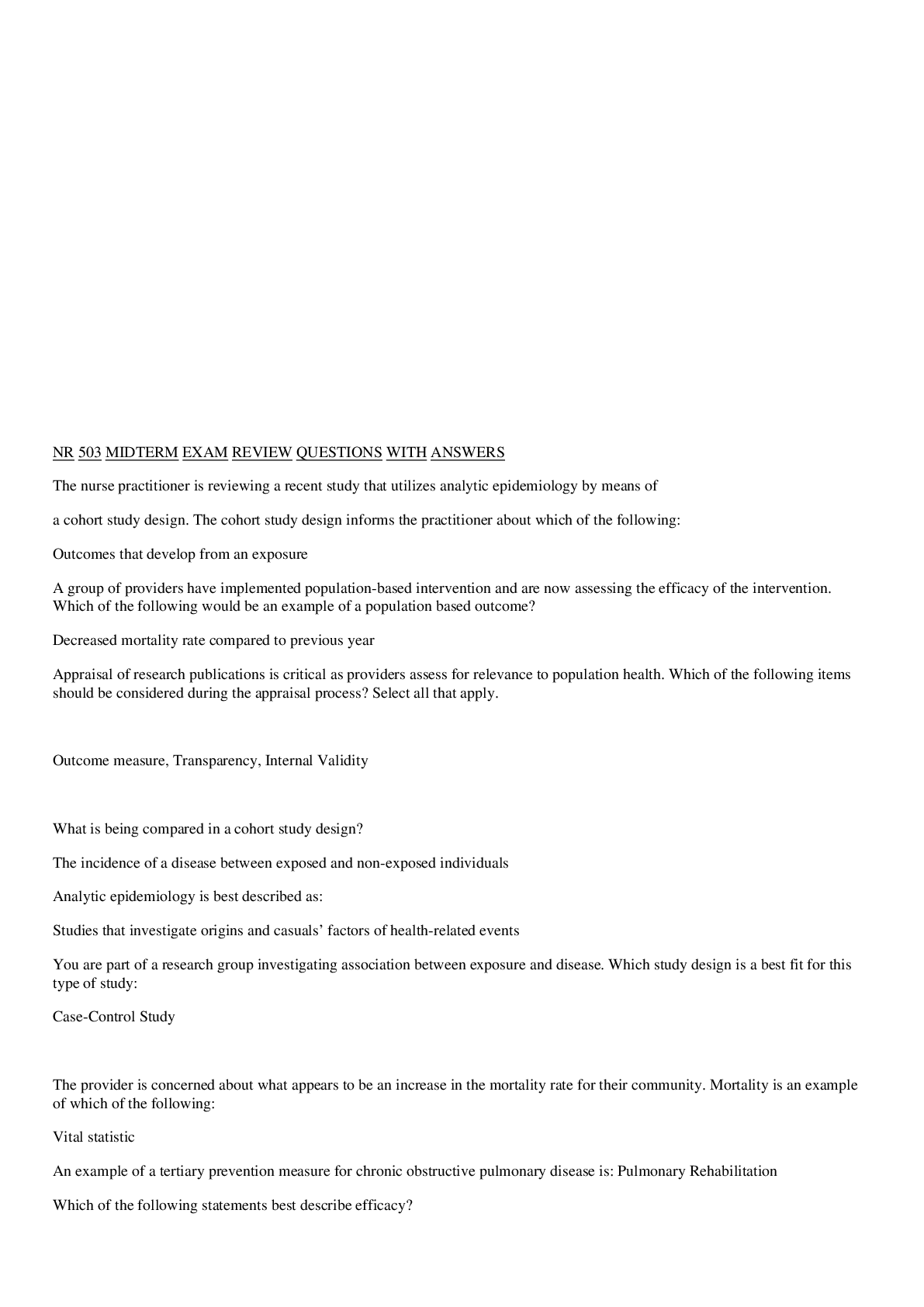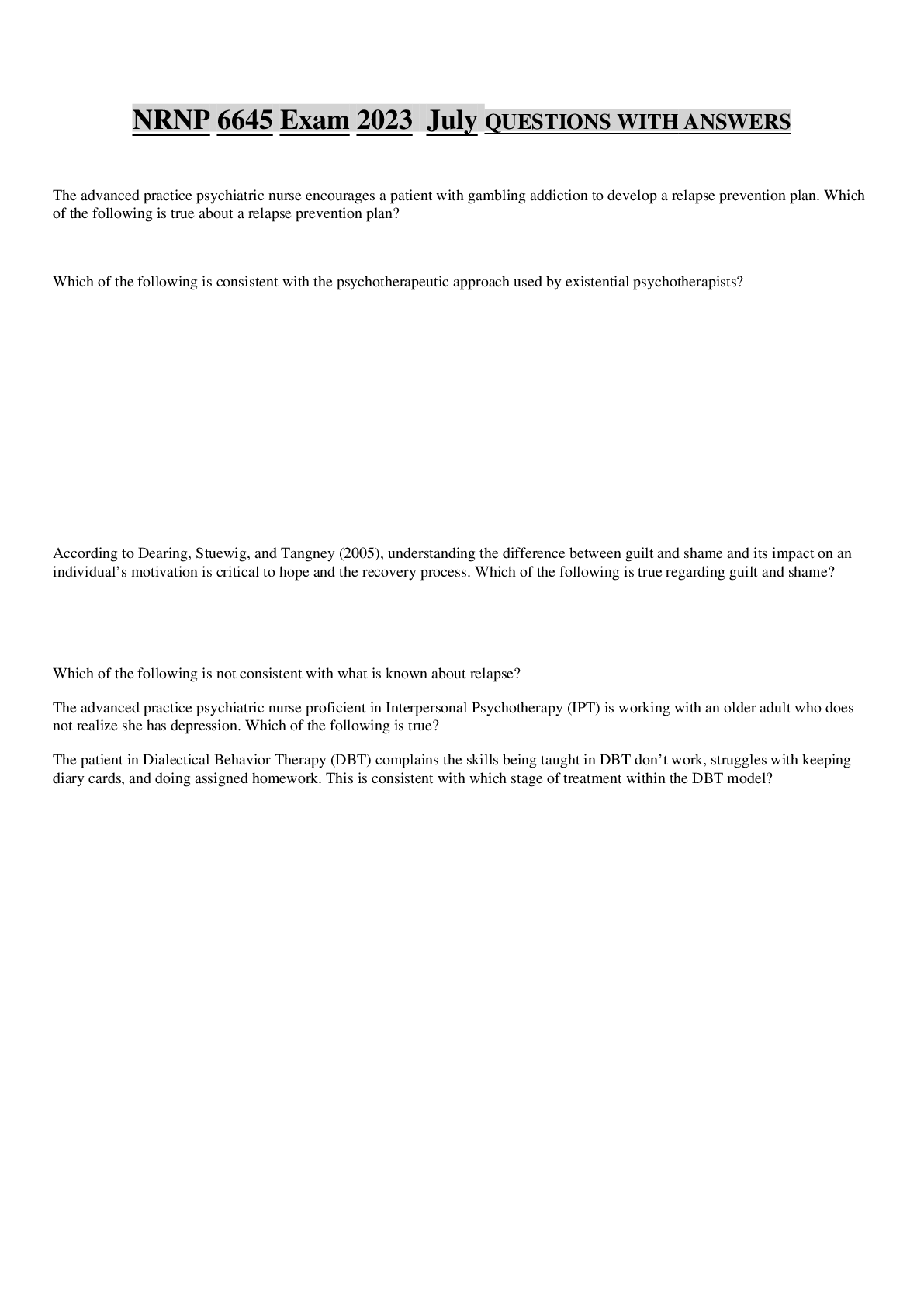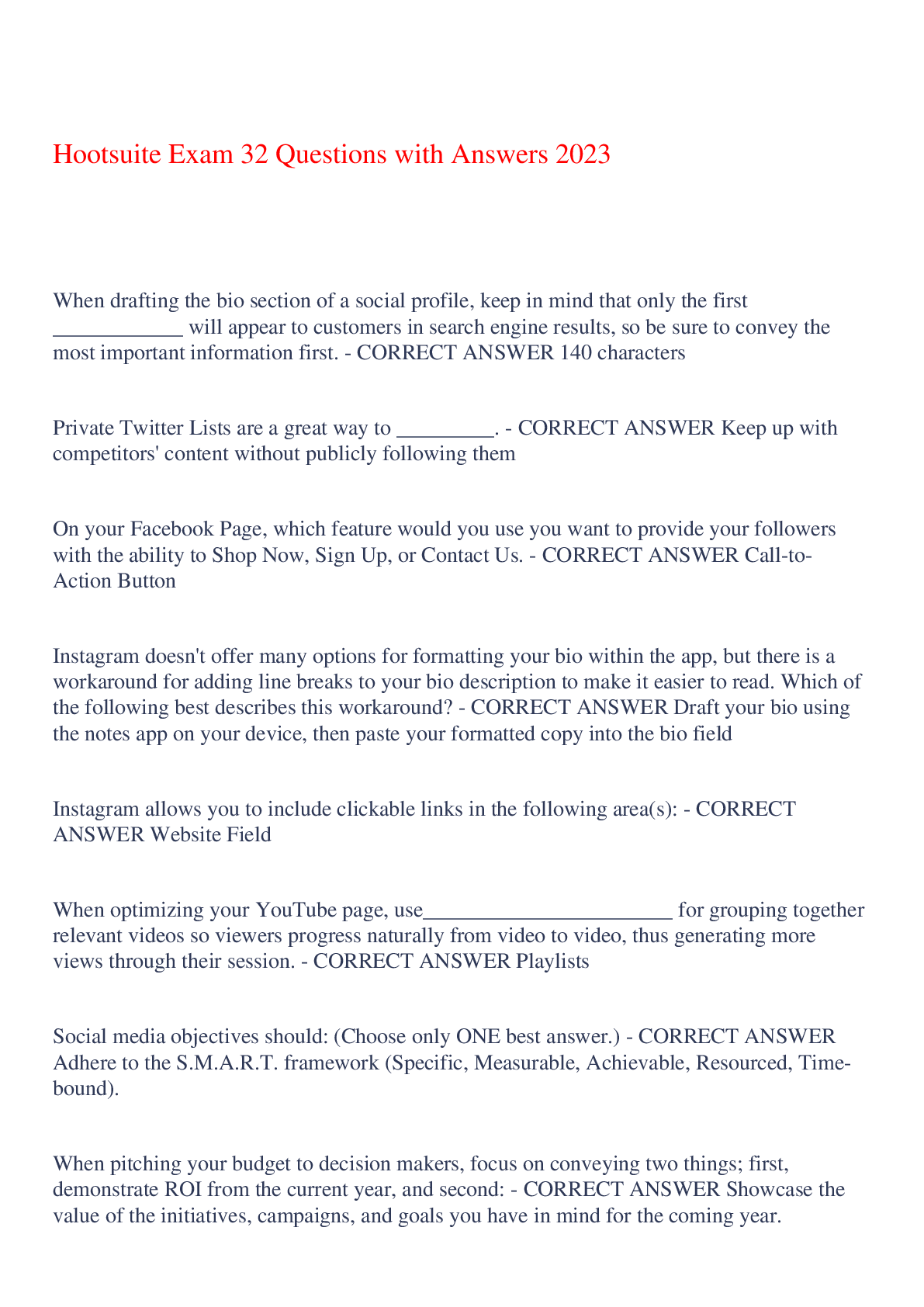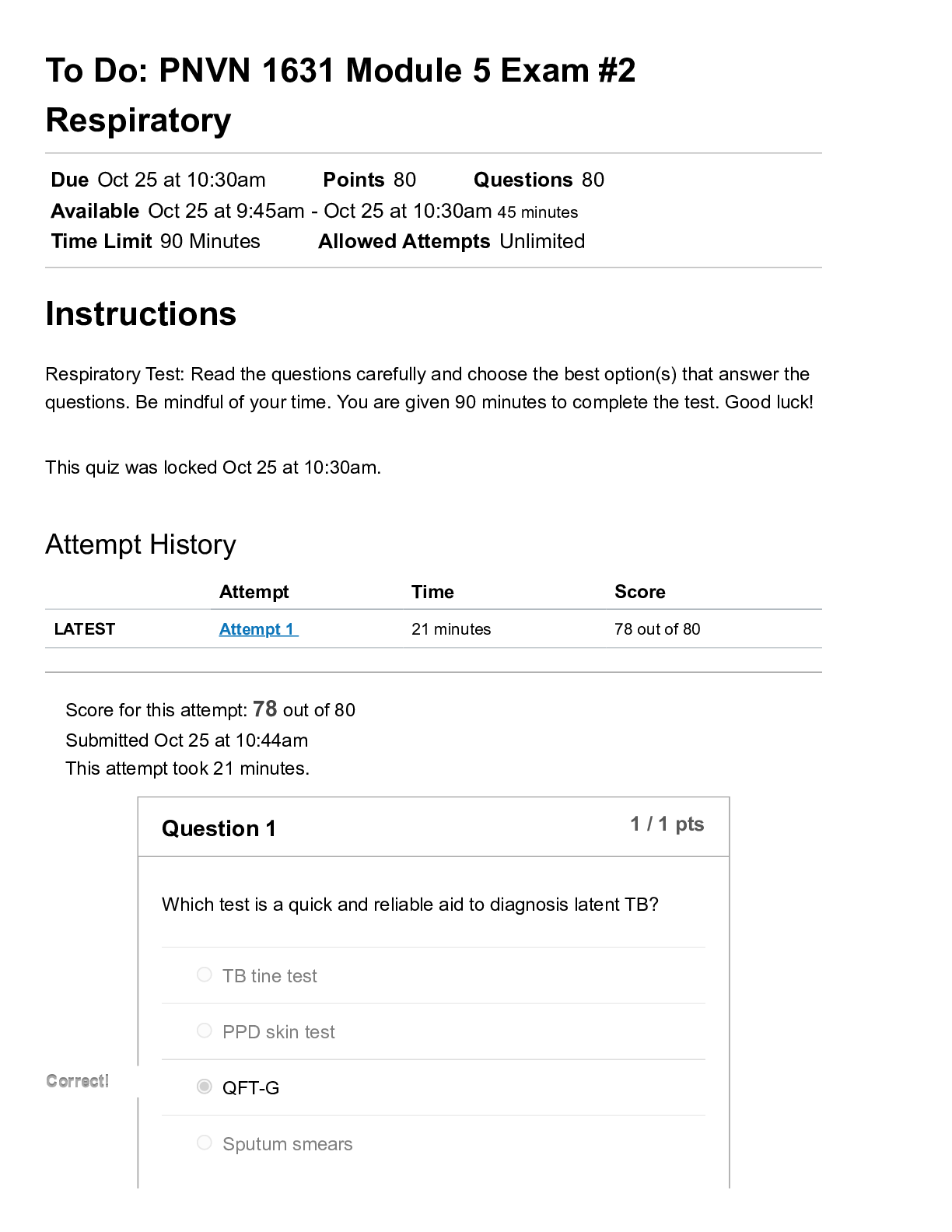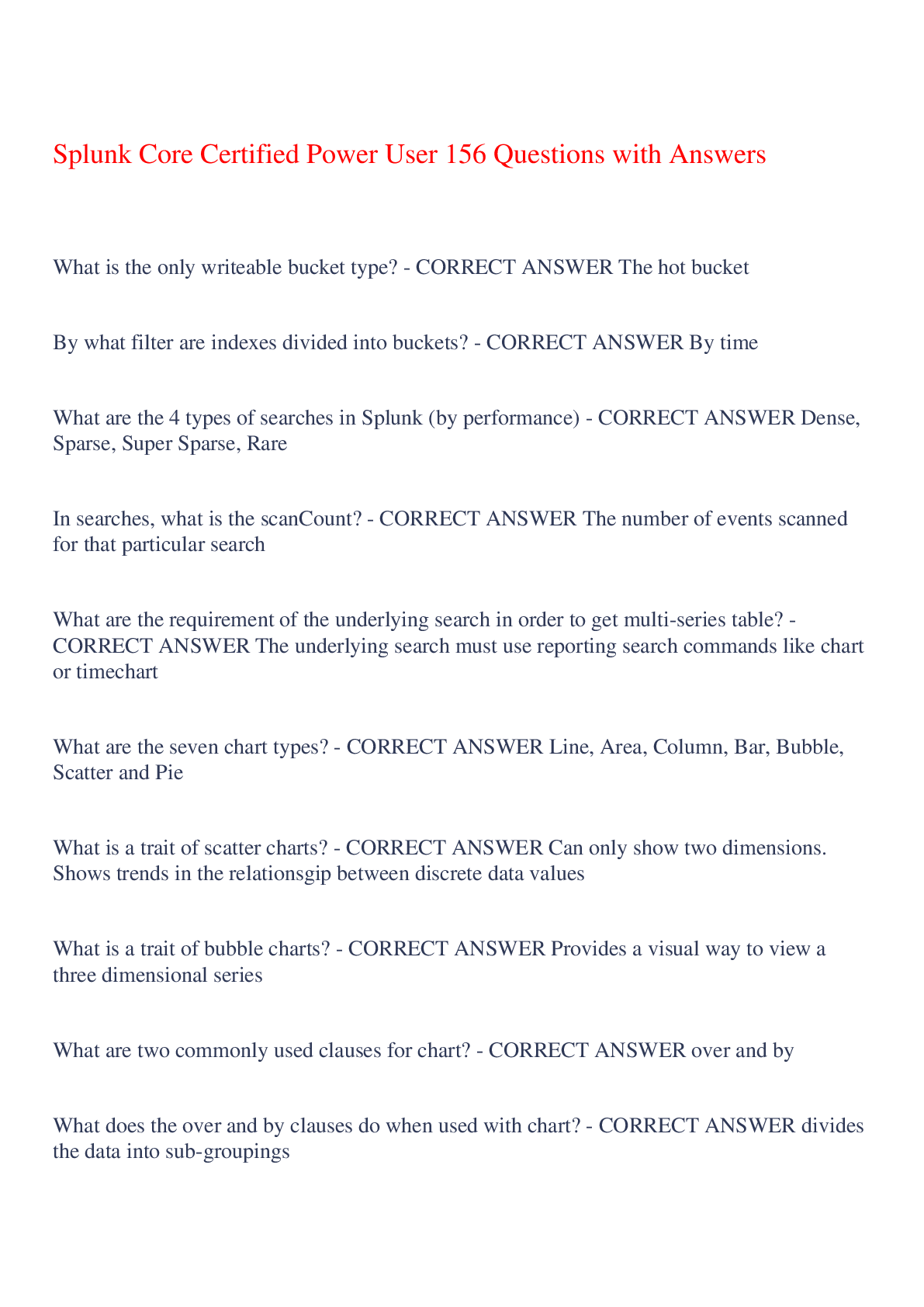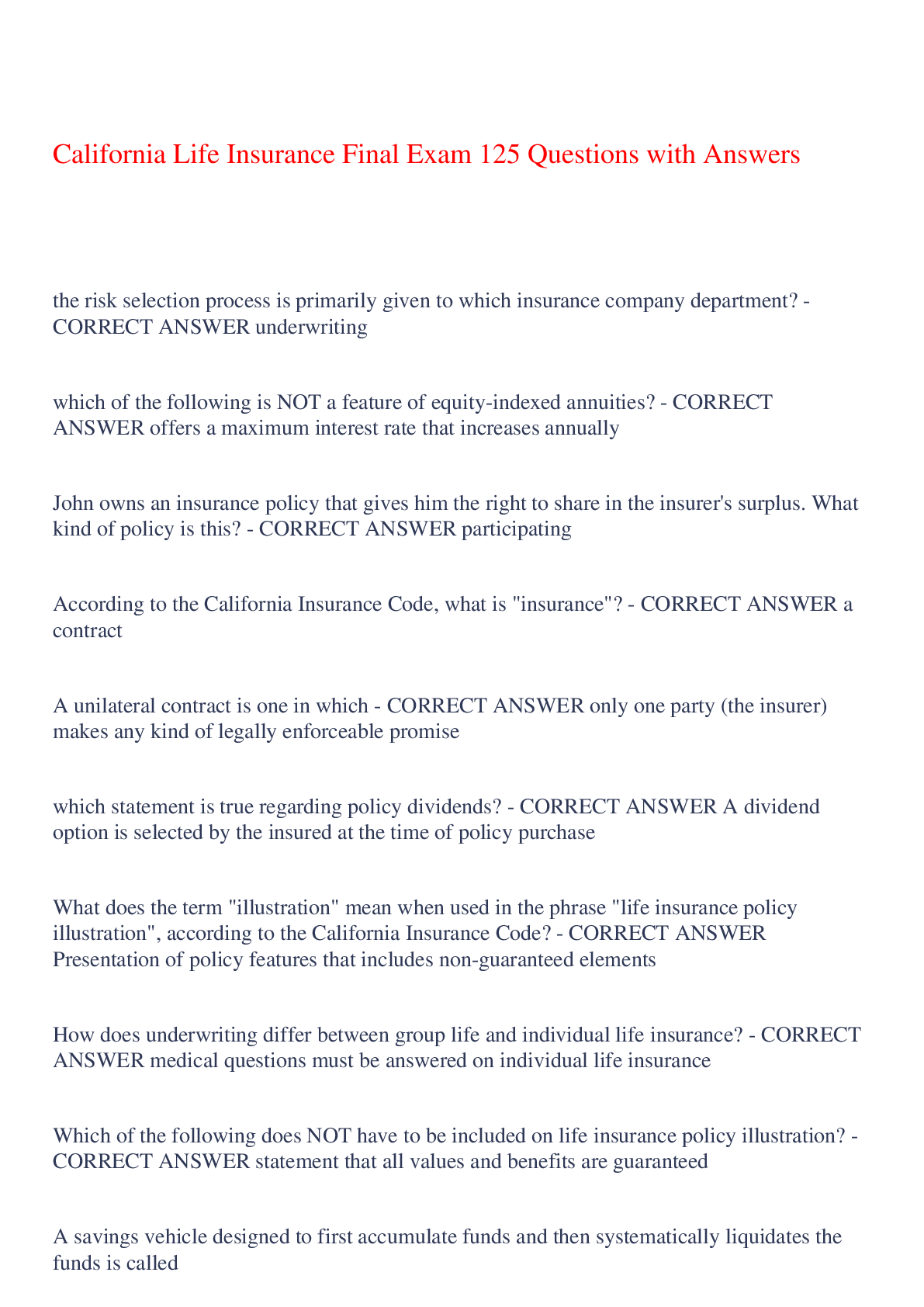Biology > EXAM > BIO 151 Module 5 Exam | Most tested questions with answers | 100% Guaranteed Pass (Portage Learning) (All)
BIO 151 Module 5 Exam | Most tested questions with answers | 100% Guaranteed Pass (Portage Learning)
Document Content and Description Below
BIO 151 Module 5 Exam Question 1 2 / 2 pts There are five types of muscle tissue found in the body. True Correct! False only 3 Question 2 2 / 2 pts Smooth and cardiac m... uscle tissue are both under voluntary control. True Correct! False Question 3 2 / 2 pts The lumbar plexus is part of the central nervous system. True Correct! False False- this is a peripheral nerve Question 4 2 / 2 pts A motor signal is a signal that is sent from a muscle to the central nervous system. True Correct! False False- this is sensory input Question 5 2 / 2 pts The lumbar plexus contains nerves that innervate the thigh. Correct Answer True You Answered False Question 6 2 / 2 pts Answer the following short-answer question: Tendons connect which types of tissue? Your Answer: Tendons connect muscle to bone tissue. Connect muscle to bone Question 7 2 / 2 pts Answer the following short-answer question: Acetylcholine is what type of substance? Your Answer: Neurotransmitter Neurotransmitter Question 8 2 / 2 pts Answer the following short-answer questions: During a muscle contraction which protein myofilament contains cross-bridges? Your Answer: Myosin Myosin Question 9 2 / 2 pts Answer the following short-answer questions: What is the name of the thick myofilament? Your Answer: Myosin Myosin Question 10 2 / 2 pts Answer the following short-answer question: The return of calcium ions into the sarcoplasmic reticulum causes what to occur? Your Answer: Cessation of muscle contraction (muscle relaxation). Muscle relaxation (Muscle contraction stops) Question 11 10 / 10 pts Label the following five muscles: A: D: F: H: I: Your Answer: A: Frontalis/ occipitofrontalis D: Orbicularis Oris F: Zygomaticus minor H: Risorius I: Masseter Question 12 10 / 10 pts Fill in the following muscle chart (10 blank spaces): Muscle Origin Insertion Action Innervation Flexor digitorum superficialis ------- ---------- 1. 2. Pronator Teres ------- 3. 4. 5. Vastus Medialis 6. ---------- 7. -------------- Peroneus Brevis 8. 9. ----------- 10. Your Answer: 1. Flexion of the wrist and digits 2-5 2. Median nerve 3. Mid-lateral surface of radius 4. Pronation 5. Median nerve 6. Intertrochanteric line of femur 7. Knee extension 8. Lateral, distal fibula 9. Lateral side of 5th metatarsal 10. Superficial peroneal nerve Question 13 2 / 2 pts Your patient sustained an injury to their facial nerve (CN VII). Which actions would be impaired? A. Eye closure B. Raising eyebrows C. Jaw closure D. Neck flexion Correct! E. A&B (Orbicularis oculi & frontalis) F. C&D Question 14 2 / 2 pts Your patient is having difficulty when asked to bring his chin to his chest. He is also having difficulty turning his face from side to side. What muscle is most likely impaired? Thyrohyoid Semispinalis capitis Splenius Capitis Correct! Sternocleidomastoid (Bilateral neck flexion, unilateral turns face) Scalenes Question 15 2 / 2 pts Your patient is having difficulty when asked to bend his spine backward. What muscle is involved? Correct! Spinalis thoracis (Extensor of the vertebral column) Scalenes External oblique Internal oblique Rectus abdominis Question 16 2 / 2 pts True or False: When a muscle contracts, the M lines within a sarcomere come closer together towards the Z line. True Correct! False Question 17 2 / 2 pts True or False: The I bands contain thick filaments. You Answered True Correct Answer False Question 18 2 / 2 pts Which muscle contracts to enable the main effort required to stand on your toes? Correct! Gastrocnemius Quadriceps Biceps femoris Tibialis anterior Question 19 0 / 2 pts When gluteus maximus contracts, which bone is pulled posteriorly by this muscle? Tibia You Answered Ilium Ulna Correct Answer Femur Question 20 2 / 2 pts When flexor digitorum profundus contracts, what action(s) occurs? A. Wrist flexion B. Elbow flexion C. Flexion of digits 2-5 D. Flexion of digit 1 Correct! E. A&C F. B&C Question 21 2 / 2 pts Contraction of results in ? obturator externus, spine flexion obturator externus, spine extension Correct! iliacus, hip flexion iliacus, hip extension Question 22 2 / 2 pts When piriformis contracts, what action(s) will not occur at the hip? A. Internal rotation B. Lateral rotation C. Adduction D. Flexion E. Extension Correct Answer F. A&D You Answered G. B&E Question 23 8 / 10 pts Use the figure answer the following five questions: 1. Which muscle has origins on both the clavicle and scapula? (specify letter on diagram with the name of the muscle for full credit) 2. Which muscle is innervated by the thoracodorsal nerve? (specify letter on diagram with the name of the muscle for full credit) 3. What is the name of muscle D? 4. What is the innervation of muscle D? 5. What is the insertion of muscle E? Your Answer: 1. A (Deltoid) 2. H or I (Lats) 3. Infraspinatus 4. Suprascapular nerve 5. Intertubercular groove of humerus (Teres major) Question 24 10 / 10 pts Use the figure to label the following six muscles: (Viewed anteriorly) A: B: C: D: E: F: Your Answer: A: Flexor carpi radialis B: Flexor digitorum superficialis C: Palmaris longus D: Flexor Carpi Ulnaris E: Flexor pollicis longus F: Flexor digitorum profundus Question 25 10 / 10 pts Use the figure to label the following six muscles: D: E: F: G: H: I: Your Answer: D: Peroneus (fibularis) longus E: Soleus F: Tibialis posterior G: Flexor digitorum longus H: Flexor hallucis longus I: Peroneus (fibularis) brevis Question 26 10 / 10 pts Answer the following essay question: Describe how acetylcholine, sodium ions and calcium ions work together to enable a muscle contraction. Your Answer: Acetylcholine (a special chemical called a neurotransmitter) is released from a motor nerve at the neuromuscular junction (or NMJ). Acetylcholine binds to receptors on the muscle fiber that cause sodium channels to open. Sodium ions rush inside the cell, triggering an action potential which eventually reaches the sarcoplasmic reticulum. Calcium ions are released from the sarcoplasmic reticulum of the muscle cell, causing a muscle contraction to occur. [Show More]
Last updated: 1 year ago
Preview 1 out of 18 pages
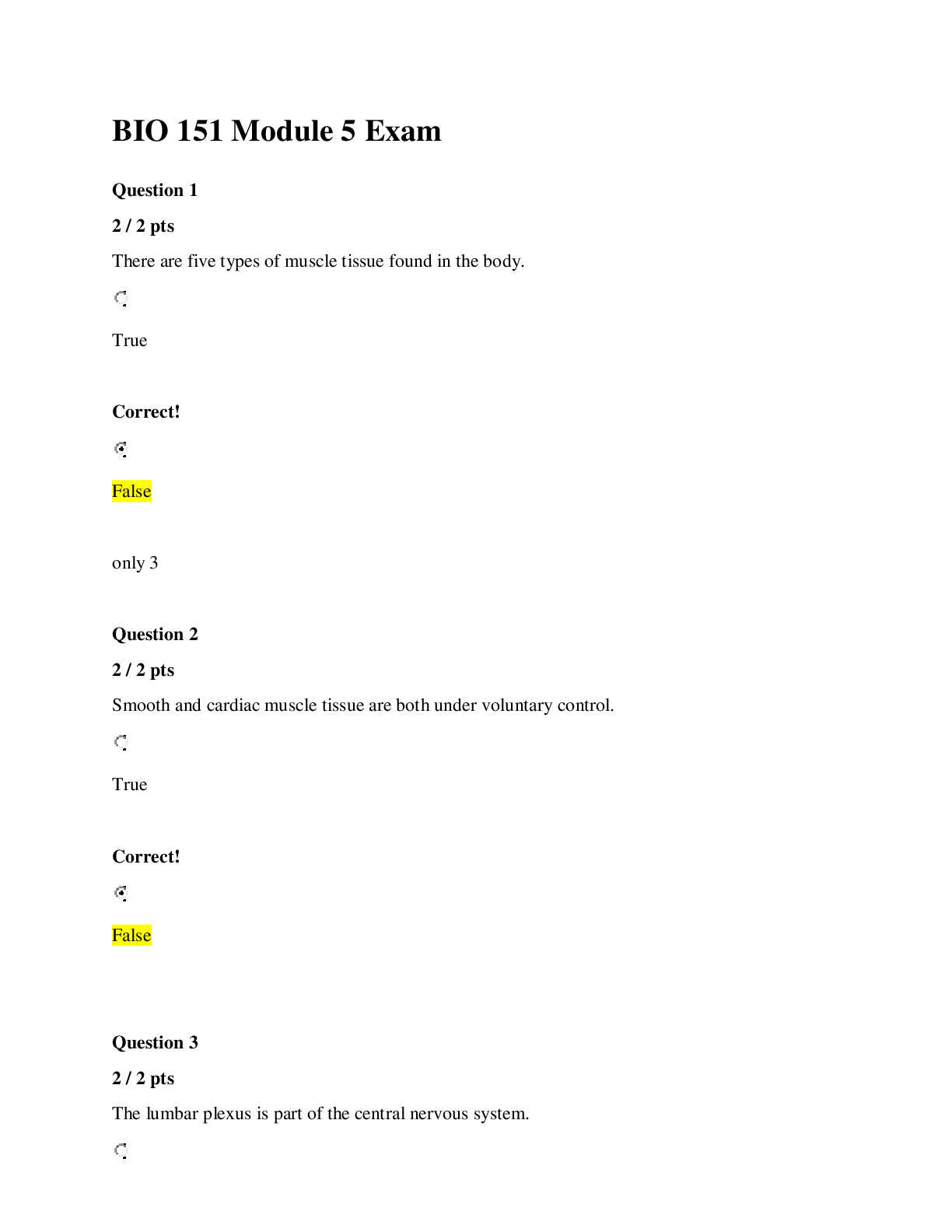
Reviews( 0 )
Document information
Connected school, study & course
About the document
Uploaded On
May 20, 2022
Number of pages
18
Written in
Additional information
This document has been written for:
Uploaded
May 20, 2022
Downloads
0
Views
37



.png)










